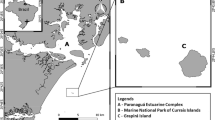Abstract
Concentrations of arsenic, cadmium, chromium, lead, manganese, mercury and selenium were examined in the down feathers and eggs of female common eiders (Somateria mollissima) from Amchitka and Kiska Islands in the Aleutian Chain of Alaska to determine whether there were (1) differences between levels in feathers and eggs, (2) differences between the two islands, (3) positive correlations between metal levels in females and their eggs, and (4) whether there was more variation within or among clutches. Mean levels in eggs (dry weight) were as follows: arsenic (769 ppb, ng/g), cadmium (1.49 ppb), chromium (414 ppb), lead (306 ppb), manganese (1,470 ppb), mercury (431 ppb) and selenium (1,730 ppb). Levels of arsenic were higher in eggs, while chromium, lead, manganese, and mercury were higher in feathers; there were no differences for selenium. There were no significant interisland differences in female feather levels, except for manganese (eider feathers from Amchitka were four times higher than feathers from Kiska). Levels of manganese in eggs were also higher from Amchitka than Kiska, and eider eggs from Kiska had significantly higher levels of arsenic, but lower levels of selenium. There were no significant correlations between the levels of any metals in down feathers of females and in their eggs. The levels of mercury in eggs were below ecological benchmark levels, and were below human health risk levels. However, Aleuts can seasonally consume several meals of bird eggs a week, suggesting cause for concern for sensitive (pregnant) women.
Similar content being viewed by others
References
ATSDR (AGENCY FOR TOXIC SUBSTANCES AND DISEASE REGISTRY). (2004). Public health assessment: Naval Air Facility, Adak. http://www.atsdr.cdc.vog/HAC/PHA/adak/ada_p1.html (accessed January 1, 2006).
Barrett, R. T., Skaare, J. U., & Gabrielsen, G. W. (1996). Recent changes in levels of persistent organochlorines and mercury in eggs of seabirds from the Barents Sea. Environmental Pollution, 92, 13–18.
Braune, B. W. (1987). Comparison of total mercury levels in relation to diet and molt for nine species of marine birds. Archives of Environmental Contamination and Toxicology, 16, 217–224.
Braune, B. W., Donaldson, G. M., & Hobson, K. A. (2002). Contaminant residues in seabird eggs from the Canadian Arctic. II. Spatial trends and evidence from stable isotopes for intercolony differences. Environmental Pollution, 117, 133–145.
Braune, B. W., & Gaskin, D. E. (1987). Mercury levels in Bonaparte’s gull (Larus philadelphia) during autumn molt in the Quoddy region, New Brunswick, Canada. Archives of Environmental Contamination and Toxicology, 16, 539–549.
Burger, J. (1993). Metals in avian feathers: Bioindicators of environmental pollution. Reviews in Environmental Toxicology, 5, 203–311.
Burger, J. (1994). Heavy metals in avian eggshells: Another excretion method. Journal of Toxicology and Environmental Health, 41, 207–220.
Burger, J. (2002). Food chain differences affect heavy metals in bird eggs in Barnegat Bay, New Jersey’. Environmental Research, 90, 33–39.
Burger, J., & Gochfeld, M. (1991). Cadmium and lead in common terns (Aves: Sterna hirundo): Relationship between levels in parents and eggs. Environmental Monitoring and Assessment, 16, 253–258.
Burger, J., & Gochfeld, M. (1996). Heavy metal and selenium levels in Franklin’s Gull (Larus pipixcan) parents and their eggs. Archives of Environmental Contamination and Toxicology, 30, 487–491.
Burger, J., & Gochfeld, M. (1997). Risk, mercury levels, and birds: Relating adverse laboratory effects to field biomonitoring. Environmental Research, 75, 160–172.
Burger, J., & Gochfeld, M. (2002). Effects of Chemicals and Pollution on Seabirds. In E. A. Schreiber, & J. Burger (Eds.) Biology of Marine Birds (pp. 485–525). Boca Raton, FL: CRC Press.
Burger, J., & Gochfeld, M. (2004). Metal levels in eggs of common terns (Sterna hirundo) in New Jersey: Temporal trends from 1971 to 2002. Environmental Research, 94, 336–343.
Burger, J., & Gochfeld, M. (2007). Metals and radionuclides in birds and eggs from Amchitka and Kiska Islands in the Bering Sea/Pacific Ocean ecosystem. Environmental Monitoring and Assessment, 127, 105–117.
Burger, J., Gochfeld, M., Kosson, D. S., & Powers, C. W. (2006a). Biomonitoring for ecosystem and human health protection at Amchitka Island. Piscataway, New Jersey: CRESP.
Burger, J., Gochfeld, M., Kosson, D., Powers, C. W., Friedlander, B., Eichelberger, J., Barnes, D., Duffy, L. K., Jewett, S. C., & Volz, C. D. (2005). Science, policy, and stakeholders: Developing a consensus science plan for Amchitka Island, Aleutians, Alaska. Environmental Management, 35, 557–568.
Burger, J., Jewett, S., Gochfeld, M., Hoberg, M., Harper, S., Chenelot, H., Jeitner, C., & Burke, S. (2006b). Can biota sampling for environmental monitoring be used to characterize benthic communities in the Aleutians. Science of the Total Environment, 369, 393–402.
DeCampo, M., Sarkis, J. E. S., Muller, R. S. S., Brabo, E. D. S., & Santos, E. D. O. (2002). Correlation between mercury and selenium concentrations in Indian hair from Rond ia state, Amazon Region, Brazil. Science of the Total Environment, 287, 155–161.
Eisler, R. (1987). Mercury hazards to fish, wildlife and invertebrates: A synoptic review. Washington DC: U. S. Fish & Wildlife Service Biological Report 85 (1.10).
EPA (Environmental Protection Agency). (2001). Environmental water quality standard: Freshwater. http://www.epa.gov/fedrgstr/EPA-WATER/2001/Juanuary/Day-08/w 217.html.
FDA (Food & Drug Administration). (2005). Answers. http://www.fda.gov/bbs/topics/ANSWERS/2005.
Fimreite, N., Brevik, F., & Trop, R. (1982). Mercury and organochlorine in eggs from a Norwegian gannet colony. Archives of Environmental Contamination and Toxicology, 28, 58–60.
Fimreite, N., Brun, E., Froslie, A., Fredrickson, P., & Gundersen, N. (1974). Mercury in eggs of Norwegian seabirds. Astarte, 1, 71–75.
Fisk, A. T., deWit, C. A., Wayland, M., Kuzyk, Z. Z., Burgess, N., Letcher, R., Braune, B., Norstrom, R., Blum, S. P., Sandau, C., Lie, E., Larsen, H. J. S., Skaare, J. U., & Muir, D. C. G. (2005). An assessment of the toxicological significance of anthropogenic contaminants in Canadian arctic wildlife. Science of the Total Environment, 351–352, 57–93.
Fitzgerald, W. F. (1989). Atmospheric and oceanic cycling of mercury. In J. P. Riley, & R. Chester (Eds.) Chemical oceanography, Vol. 10 (pp. 151–186). New York: Academic Press.
Franson, J. C., Hollmen, T., Poppenga, R. H., Hario, M., Kilpi, M., & Smith, M. R. (2000). Selected trace elements and organochlorines: Some findings in blood and eggs of nesting common eiders (Somateria mollissima) from Finland. Environmental Toxicology and Chemistry, 19, 1340–1347.
Furness, R. W. (1993). Birds as monitors of pollutants. In R. W. Furness, & J. J. D. Greenwood (Eds.) Birds as monitors of environmental change (pp. 86–143). London, UK: Chapman & Hall.
Furness, R. W., & Camphuysen, K. C. J. (1997). Seabirds as monitors of the marine environment. Journal of Marine Science, 54, 726–737.
Furness, R. W., Muirhead, S. J., & Woodburn, M. (1986). Using bird feathers to measure mercury in the environment: Relationship between mercury content and moult. Marine Pollution Bulletin, 17, 27–37.
Furness, R. W., & Rainbow, P. S. (Eds.) (1990). Heavy metals in the marine environment. Boca Raton, Florida: CRC Press.
Gochfeld, M. (1980). Mercury levels in some seabirds of the Humboldt Current, Peru. Environmental Pollution, A 22, 197–205.
Goede, A. A., & deBruin, M. (1986). The use of feathers for indicating heavy metal pollution. Environmental Monitoring and Assessment, 7, 249–256.
Goudie, R. I., Robertson, G. J., & Reed, A. (2000). Common eider. Birds of North America, 546, 1–32.
Kenyon, K. W. (1961). Birds of Amchitka Island, Alaska. Auk, 78, 305–326.
Lewis, S. A., & Furness, R. W. (1991). Mercury accumulation and excretion by laboratory reared black-headed Gulls (Larus ridibundus) chicks. Archives of Environmental Contamination and Toxicology, 21, 316–320.
Mallory, M. L., Braune, B. M., Wayland, M., Gilchrist, H. G., & Dickson, D. L. (2004). Contaminants in common eiders (Somateria mollissima) of the Canadian Arctic. Environmental Research, 12, 197–218.
Merritt, M. L., & Fuller, R. G. (Eds.) (1977). The environment of Amchitka Island, Alaska. U.S. Washington DC; Report NVO-79, Technical Information Center, Energy Research and Development Administration.
Mierzykowski, S. E., Welch, L. J., Goodale, W., Evers, D. C., Hall, C. S., Kress, S. W., & Allen, R. B. (2005). Mercury in bird eggs from coastal Maine. U.S. Fish & Wildlife Service; project report FY05-MEFO-1-EC.
Monteiro, L. R. (1996). Seabirds as monitors of mercury in the marine environment. Water, Air and Soil Pollution, 80, 851–870.
Monteiro, L. R., & Furness, R. W. (1995). Seabirds as monitors of mercury in the marine environment. Water, Air and Soil Pollution, 80, 831–870.
Nygard, T., Lie, E., Roy, N., & Steinnes, E. (2001). Metal dynamics in an Antarctic food chain. Marine Pollution Bulletin, 42, 598–602.
Ohlendorf, H. M., Risebrough, R. W., & Vermeer, K. (1978). Exposure of marine birds to environmental pollutants. US Fish.& Wildl. Serv. Wildl. Res. Rep., 9.
Peakall, D. B. (1992). Animal biomarkers as pollution indicators. London, UK: Chapman & Hall.
Pearce, P. A., Peakall, D. B., & Reynolds, L. M. (1979). Shell thinning and residues of organochlorines and mercury in seabird eggs, Eastern Canada, 1970–1076. Pesticides Monitoring Journal, 13, 61–58.
Powers, C. W., Burger, J., Kosson, D., Gochfeld, M., & Barnes, D. (Eds.) (2005). Biological and geophysical aspects of potential radionuclide exposure in the Amchitka marine environment. Piscataway, New Jersey: CRESP.
SAS (1995). SAS users’ guide. Cary, North Carolina: SAS Institute.
Thompson, D. R., & Furness, R. W. (1989). Comparison of the levels of total and organic mercury in seabird feathers. Marine Pollution Bulletin, 20, 577–579.
Thompson, D. R., & Furness, R. W. (1998). Seabirds as biomonitors of mercury inputs to epipelagic and mesopelagic marine food chains. Science of the Total Environment, 213, 299–305.
Walsh, P. M. (1990). The use of seabirds as monitors of heavy metals in the marine environment. In R. W. Furness, & P. S. Rainbow (Eds.) Heavy metals in the marine environment (pp. 183–204). Boca Raton, Florida: CRC Press.
Wayland, M., Gilchrist, H. G., & Neugebauer, E. (2005). Concentrations of cadmium, mercury and selenium in common eider ducks in the eastern Canadian arctic: Influence of reproductive stage. Science of the Total Environment, 351, 323–332.
World Health Organization (WHO). (1990). IPCS-Methylmercury. Environmental Health Criteria, 101. Geneva.
World Health Organization (WHO). (1991). IPCS-Inorganicmercury. Environmental Health Criteria, 118. Geneva.
Author information
Authors and Affiliations
Corresponding author
Rights and permissions
About this article
Cite this article
Burger, J., Gochfeld, M., Jeitner, C. et al. Assessment of metals in down feathers of female common eiders and their eggs from the Aleutians: arsenic, cadmium, chromium, lead, manganese, mercury, and selenium. Environ Monit Assess 143, 247–256 (2008). https://doi.org/10.1007/s10661-007-9973-y
Received:
Accepted:
Published:
Issue Date:
DOI: https://doi.org/10.1007/s10661-007-9973-y




